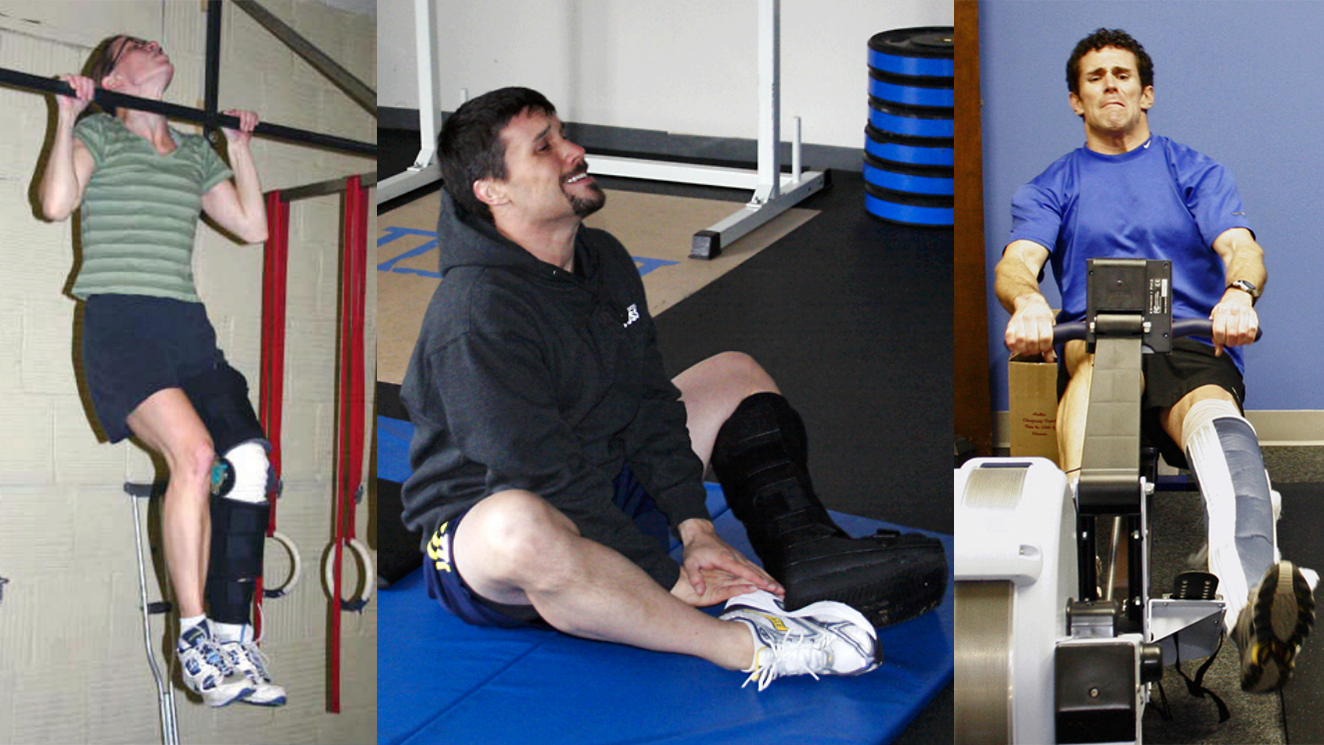Injury, like illness, is an ineluctable fact of life. In sport, elite performers are more marked by the attitude and manner with which they deal with injury than by their elected course of treatment or by the severity or frequency of their injuries.
Whereas treatment and rehabilitation receive considerable attention and focus in discussing injury, compensatory strategies for maintaining or improving fitness while recovering from injury are generally given short shrift.

This month we reveal the CrossFit approach to training with injury through the hypothetical case of an athlete medically restricted from all weight-bearing movements for eight weeks following surgical repair of the meniscus in his right knee.
Remember, our concern here is not how to “rehab” the knee specifically but how to keep the athlete training to ensure that he continues to develop while he is injured and unable to use the affected limb.
Our hypothetical case of a disabled right leg is somewhat arbitrary but represents considerable complication for any CrossFitter in that the legs are used in virtually every CrossFit workout. However, similar strategies and mindset can be applied successfully to nearly any orthopedic injury. And while our case is hypothetical, we are intimate personally and professionally with extremity injury and with successful application of the approach we describe.
In traditional rehabilitation the goal is to bring the afflicted body part, and eventually the athlete, back to preinjury capacity. This, though frequently a formidable challenge, is not by itself adequate to the aims of CrossFit rehab. For CrossFitters, rehabilitation is complete and successful when the athlete has acquired total physical capacity not just equal to but beyond the pre-injury state.
The overwhelming majority of recovery from injury is performed by nature. Surgery, hydrotherapy, ultrasound, exercise and other treatment modalities, while being useful or even essential, are not going to take the athlete’s fitness beyond his pre-injury state—our stated rehab goal.

The essence of our approach to working wounded is to divert the focus and purpose of the athlete’s workout away from the injured limb. We want the athlete to work with intensity, variance and functionality but just, in our hypothetical case, not with the right leg.
Restricted from load bearing for eight weeks, our hypothetical athlete (let’s call him “Mac”) will be unable to perform the WOD unmodified for nearly three months and without full gusto for as long as six months.
Mac’s rehabilitation begins with the simple proclamation not that he is injured but that he is “about to begin a six-month-long intensive gymnastic program.” For the next six months Mac is going to be building workouts from the upper body and left leg. His workout life will be built around rings, parallettes, dumbbells, a climbing rope, a glute-ham developer, a handbike and the floor.
We will start with a checklist of some goals for upper-body performance. Mac currently has 20 pull-ups; he’s going to have 40 in six months. Similarly, his handstand push-ups will increase from 10 to 25, and consecutive muscle-ups from 3 to 15. We might set 10 or so goals for Mac in this way. These goals should be past what Mac has thought he would ever be capable of. He will achieve these goals because fate has dealt him the specialist’s hand and he will reap the specialist’s rewards.
Additionally, we will make a list of some movements that have always been out of Mac’s reach and start training for them. He has no front lever now; he will in six months. Mac has always wanted a planche; we will put it on the list and plan for specific drills to develop the planche.

Mac is going to be spending a lot of time upside down over the next six months. He will drill handstands and presses to handstands from the parallettes and floor constantly. Knees-to-elbows, crunches, sit-ups, hollow rocks, hollow arches, hug-a-twinkies, pass-throughs, skin-the-cats, and every trunk and core exercise known to god, man and CrossFit not involving the right leg will get the attention that only the bad luck of a leg injury could provide.
Mac’s routines are pure CrossFit with a “skills and drills” component before and/or after the workout.
There’s really nothing different in the programming. Mac is doing what we wanted him to do before he got hurt. He’s still doing varied, intense workouts that comprise full-body functional movements; the list of exercises he draws from is just more circumscribed.
There’s focus or specialization where it may not have made sense before. Mac’s injury is a mixed blessing.
Whatever potential development Mac missed by having to forego the full range of workouts following his injury is going to be replaced with skills that he was not likely to have developed otherwise. The exact nature of the tradeoff is necessarily blurred, as an unknown loss in potential is exchanged for a measurable, valuable and potent adaptation attributable directly to the injury’s effect on his training. Now that is rehab.

Before Mac’s leg is 100 percent again he will have made gains in upper-body and trunk strength, flexibility (he’s going to stretch regularly for perhaps the first time in his life), balance, agility and coordination that will remain with him for the rest of his life.
The advantages to recovering CrossFit-style over watching TV and waiting for the leg to heal are threefold. First, the injured leg will heal more quickly and atrophy less. Second, Mac will acquire skills and strengths that he wouldn’t have developed otherwise. Third, the mental anguish that nearly always accompanies an athlete’s down time is greatly reduced.
This article, by BSI’s co-founder, was originally published in The CrossFit Journal. While Greg Glassman no longer owns CrossFit Inc., his writings and ideas revolutionized the world of fitness, and are reproduced here.
Coach Glassman named his training methodology ‘CrossFit,’ which became a trademarked term owned by CrossFit Inc. In order to preserve his writings in their original form, references to ‘CrossFit’ remain in this article.
- Download Original PDF
- Download Español (Spanish) PDF
- Download Português (Portuguese) PDF
- Download Italiano (Italian) PDF
- Download Français (French) PDF
Greg Glassman founded CrossFit, a fitness revolution. Under Glassman’s leadership there were around 4 million CrossFitters, 300,000 CrossFit coaches and 15,000 physical locations, known as affiliates, where his prescribed methodology: constantly varied functional movements executed at high intensity, were practiced daily. CrossFit became known as the solution to the world’s greatest problem, chronic illness.
In 2002, he became the first person in exercise physiology to apply a scientific definition to the word fitness. As the son of an aerospace engineer, Glassman learned the principles of science at a young age. Through observations, experimentation, testing, and retesting, Glassman created a program that brought unprecedented results to his clients. He shared his methodology with the world through The CrossFit Journal and in-person seminars. Harvard Business School proclaimed that CrossFit was the world’s fastest growing business.
The business, which challenged conventional business models and financially upset the health and wellness industry, brought plenty of negative attention to Glassman and CrossFit. The company’s low carbohydrate nutrition prescription threatened the sugar industry and led to a series of lawsuits after a peer-reviewed journal falsified data claiming Glassman’s methodology caused injuries. A federal judge called it the biggest case of scientific misconduct and fraud she’d seen in all her years on the bench. After this experience Glassman developed a deep interest in the corruption of modern science for private interests. He launched CrossFit Health which mobilized 20,000 doctors who knew from their experiences with CrossFit that Glassman’s methodology prevented and cured chronic diseases. Glassman networked the doctors, exposed them to researchers in a variety of fields and encouraged them to work together and further support efforts to expose the problems in medicine and work together on preventative measures.
In 2020, Greg sold CrossFit and focused his attention on the broader issues in modern science. He’d learned from his experience in fitness that areas of study without definitions, without ways of measuring and replicating results are ripe for corruption and manipulation.
The Broken Science Initiative, aims to expose and equip anyone interested with the tools to protect themself from the ills of modern medicine and broken science at-large.
Support the Broken Science Initiative.
Subscribe today →




